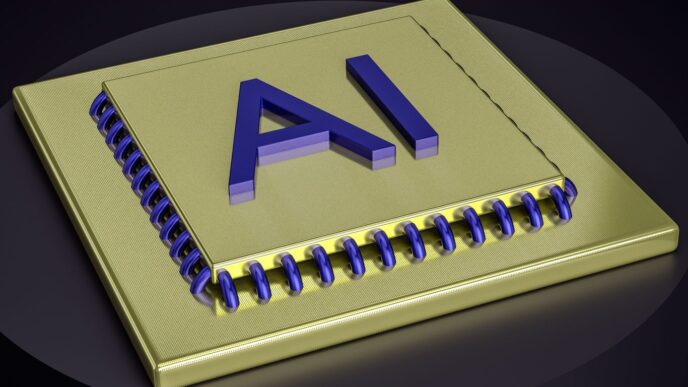Everyone’s heard about companies like Neuralink, right? They’re always in the news for their brain chip stuff. But honestly, there’s a whole lot more happening in the world of brain-computer interfaces (BCIs) than just what Elon Musk is doing. It’s a really exciting time, with tons of different groups working on some wild tech that could change how we live. We’re talking about things that could help people with disabilities, or even just make us all a bit smarter. It’s not just one company leading the charge; it’s a whole bunch of smart people pushing the limits.
Key Takeaways
- The BCI field is big, with many companies beyond just Neuralink making real progress.
- Different companies are trying out various ways to connect brains and computers.
- There’s a lot of money going into these BCI startups, which means more new stuff is coming.
- Thinking about the right and wrong ways to use this tech is super important as it grows.
- The future of BCIs might involve mixing human smarts with artificial intelligence.
The Expanding Frontier of Brain-Computer Interfaces
Beyond Neuralink: A Diverse Landscape
Okay, so everyone’s heard of Neuralink, right? But the BCI world is way bigger than just one company. There’s a whole bunch of different players out there, all working on cool stuff. It’s not just about Elon Musk anymore. You’ve got companies focusing on different approaches, different applications, and different parts of the brain. It’s like a tech ecosystem, with everyone trying to solve the same problem in their own way. It’s actually pretty exciting to see all the innovation happening.
Pioneering Advancements in Neurotechnology
We’re seeing some serious progress in neurotech. It’s not just science fiction anymore. New materials, better algorithms, and more sophisticated implants are making BCIs more effective and reliable. For example, Synchron’s focus on communication has enabled applications such as restoring speech in ALS patients. Plus, researchers are figuring out how to get better signals from the brain, which means more precise control and more useful data. It’s a slow process, but every year we’re getting closer to BCIs that can really make a difference in people’s lives.
The Promise of Enhanced Human Capabilities
BCIs aren’t just about treating diseases or disabilities. They also hold the potential to enhance human capabilities. Imagine being able to control devices with your mind, learn new skills faster, or even communicate telepathically. It sounds like something out of a movie, but it’s becoming more and more realistic. Of course, there are ethical questions to consider, but the potential benefits are huge. It’s not just about fixing problems, it’s about making us better, faster, stronger. The possibilities are kind of mind-blowing, to be honest.
Key Players Shaping the BCI Ecosystem
It’s not just Neuralink out there pushing the boundaries of brain-computer interfaces. A whole bunch of companies are working on some seriously cool stuff, each with their own approach and focus. Let’s take a look at some of the key players making waves in this space.
Synchron: A Formidable Competitor
Synchron is definitely one to watch. They’ve developed a BCI that’s less invasive than Neuralink’s, and it’s already being used in human trials. They’re making real progress in helping people with paralysis regain some independence. Plus, they’ve been integrating AI to help non-verbal people communicate, which is a game-changer. It’s pretty amazing to see how Synchron has integrated generative AI into its BCI system.
Paradromics: High-Resolution Neural Data
Paradromics is taking a different route, focusing on gathering really detailed neural data. They’re working on high-bandwidth BCIs for neurological studies that could give us a much better understanding of the brain. Their clinical trials are a big deal, and their partnership with NEOM shows they’re thinking big in terms of expanding their reach. It’ll be interesting to see how their tech impacts medical practices and tech innovations.
Kernel: Advancing Neuroprosthetics
Kernel is all about non-invasive BCI tech. They’re using methods like EEG and fNIRS to capture brain signals without surgery. While it might not be as precise as implantable stuff, it’s way safer and more accessible. They’re looking at applications from neurorehabilitation to virtual reality, which could open up BCI to a much wider audience. It’s cool to see companies leveraging non-invasive methods to make BCI more accessible.
Innovative Approaches in BCI Development
Implantable Versus Non-Invasive Solutions
When it comes to brain-computer interfaces, there are generally two main ways to go: implantable and non-invasive. Implantable BCIs, like the ones Neuralink develops, involve surgery to place electrodes directly in the brain. This allows for really precise readings and control. On the other hand, non-invasive BCIs use things like EEG caps to read brain activity from outside the skull. Non-invasive methods are safer and easier to use, but they don’t offer the same level of precision. It’s a trade-off between risk and reward, and different companies are betting on different approaches.
Hybrid Systems and Advanced Electronics
Some researchers are exploring hybrid systems that combine the best of both worlds. These might involve minimally invasive implants paired with external sensors to get a more complete picture of brain activity. Also, advances in electronics are making BCIs smaller, more powerful, and more energy-efficient. This means longer battery life and more comfortable devices for users. It’s all about finding the right balance of technology to make BCIs practical for everyday use.
Focus on Neurological Disorder Treatment
One of the biggest areas of focus for BCI development is treating neurological disorders. BCIs can help people with paralysis regain movement, restore communication for those with speech impairments, and even alleviate symptoms of conditions like epilepsy and Parkinson’s disease. For example, Synchron’s Stentrode is designed to help people with neurological disorders control external devices. The potential to improve the lives of people with these conditions is a major driving force behind BCI research.
Funding and Global Expansion in Neurotech
Significant Investments in BCI Startups
It’s wild to see how much money is flowing into brain-computer interface (BCI) startups these days. You’ve got companies like Neuralink grabbing headlines, but there are tons of others also getting serious funding. This isn’t just small change; we’re talking about investments that could really change the game. The influx of capital is fueling innovation and accelerating the development of new technologies. It’s like a space race, but for your brain. I saw a funding histogram that really puts it into perspective.
International Collaborations and Partnerships
Neurotech isn’t just a U.S. thing; it’s going global. Companies are teaming up across borders to share knowledge, resources, and expertise. This is super important because it means that the best minds from all over the world are working together to solve some really tough problems. Plus, it opens up new markets and opportunities for growth. Paradromics, for example, has a partnership with Saudi Arabia’s NEOM project, which shows how far-reaching these collaborations can be. It’s not just about the tech; it’s about building a global network.
Navigating the Complex Neurotech Landscape
Let’s be real, the neurotech world is complicated. There are regulations, ethical considerations, and a whole bunch of technical challenges to deal with. Companies need to be smart about how they navigate this landscape if they want to succeed. It’s not enough to just have a cool product; you need to know how to get it approved, how to market it responsibly, and how to build trust with the public. It’s a tough balancing act, but the companies that can pull it off are the ones that are going to make a real difference. Clinical trials are a big part of this, and clinical trials are essential for getting FDA approval.
Ethical Considerations and Societal Impact

Addressing Ethical Challenges in Brain Tech
Brain-computer interfaces (BCIs) hold incredible promise, but we can’t ignore the ethical minefield that comes with them. It’s not just about the tech working; it’s about making sure it’s used responsibly. One of the biggest concerns revolves around data privacy and security. Imagine someone hacking into your brain – scary, right? We need strong safeguards to prevent misuse and protect personal neural data. Also, questions about autonomy and identity come into play. If a BCI can alter your thoughts or behaviors, where do you draw the line? These are tough questions with no easy answers.
Regulatory Frameworks for Emerging Technologies
Right now, the regulatory landscape for BCIs is still pretty hazy. We need clear guidelines and standards to ensure safety and efficacy. Think about it – these devices are going directly into or interacting with our brains. The FDA and other regulatory bodies need to step up and create frameworks that address the unique risks associated with neurotechnology. This includes things like clinical trial protocols, manufacturing standards, and post-market surveillance. It’s a complex task, balancing innovation with responsible development. Without proper oversight, we risk jeopardizing public trust and hindering the progress of the field.
Redefining Human Interaction with BCIs
BCIs have the potential to change how we interact with each other and the world around us. Imagine a future where communication is instantaneous, or where physical limitations are a thing of the past. But this also raises some profound questions. Will BCIs exacerbate existing inequalities? Will they create new forms of discrimination? How will they affect our sense of empathy and connection? We need to think critically about the societal implications of these technologies and work to ensure that they benefit everyone, not just a select few. It’s about shaping a future where BCIs augment cognitive capabilities in a way that enhances, rather than diminishes, our humanity.
Here’s a quick look at some key ethical considerations:
- Privacy: Protecting neural data from unauthorized access.
- Autonomy: Ensuring users retain control over their thoughts and actions.
- Equity: Making BCI technology accessible to all, regardless of socioeconomic status.
- Safety: Minimizing the risks associated with implantable devices.
The Future Trajectory of Brain Interface Technology
Unlocking the Full Potential of BCIs
Okay, so where are we headed with all this brain-computer interface stuff? It’s not just about cool gadgets; it’s about fundamentally changing how we interact with the world. The real potential lies in restoring lost functions, like speech, and augmenting our cognitive abilities. Think about it:
- Helping people with paralysis regain movement.
- Allowing us to control devices with our minds.
- Potentially even boosting memory and learning.
Synchron integrated generative AI into its BCI system, which is a huge step. But there are still hurdles, like making implants more biocompatible and improving signal processing. The BCI market is expected to reach billions in the next few years, so there’s a lot of incentive to keep pushing forward.
Merging Human Intelligence with AI
This is where things get really interesting. Imagine combining the power of the human brain with the capabilities of artificial intelligence. It’s not just science fiction anymore. We’re talking about:
- AI-powered BCIs that can learn and adapt to individual needs.
- Using AI to decode complex brain signals and translate them into actions.
- Potentially creating a new form of human-AI collaboration.
But, of course, there are ethical considerations. We need to think about things like privacy, security, and the potential for misuse. It’s a wild west out there, and we need to make sure we’re building responsibly.
Continuous Innovation and Research
The BCI field is moving fast. New materials, better algorithms, and innovative approaches are constantly emerging. Companies like Neuralink are pushing the boundaries of what’s possible with implantable technology, while others are exploring non-invasive solutions. It’s a diverse landscape, and there’s no one-size-fits-all answer.
Here’s a quick look at some key areas of research:
| Area | Focus |
|---|---|
| Electrode Design | Creating more stable and biocompatible implants. |
| Signal Processing | Improving the accuracy and reliability of neural signal decoding. |
| AI Integration | Developing AI algorithms that can enhance BCI performance. |
| Ethical Considerations | Addressing the ethical and societal implications of BCI technology. |
Ultimately, the future of BCIs depends on continued innovation and a commitment to responsible development. We need to keep pushing the boundaries of what’s possible while also ensuring that these technologies are used for the benefit of humanity. Sustained attention is key to making sure we get there.
Distinguishing Features of Leading BCI Companies
Neuralink’s Vision for Human Augmentation
Neuralink, spearheaded by Elon Musk, is really shooting for the stars. Their main goal is to create brain-machine interfaces that you can actually implant, hoping to boost what humans can do. They’re thinking big – like, connecting your brain to computers with a super-fast connection. The idea is to help with neurological problems and maybe even merge humans with AI someday. It’s a pretty wild vision, and they’re definitely grabbing headlines with their progress. They want to create a high-bandwidth connection between the brain and computers.
Synchron’s Focus on Communication
Synchron is taking a different route. While Neuralink is aiming for broad human enhancement, Synchron is laser-focused on helping people communicate. They’ve developed a BCI that’s already helping people with paralysis use their thoughts to control digital devices. It’s about restoring lost function and giving people back their voice, literally. They’ve even added AI to their system, letting people generate text and audio just by thinking. It’s a more practical, here-and-now approach compared to Neuralink’s long-term vision. Synchron has integrated generative AI into its BCI system.
Paradromics’ Clinical Trial Preparations
Paradromics is all about getting super-detailed neural data. They’re working on high-resolution interfaces that can record a ton of information from the brain. This kind of data is crucial for understanding how the brain works and for developing new treatments for neurological disorders. They’re gearing up for clinical trials, which means they’re getting ready to test their technology in real people. It’s a big step, and it could pave the way for some serious breakthroughs in how we treat brain-related conditions. Paradromics is preparing for clinical trials with their technology.
Conclusion
So, what’s the big takeaway here? The world of brain-computer interfaces, or BCIs, is way bigger than just Neuralink. You’ve got all these different companies, some big, some small, all trying to figure out how our brains can talk to computers. It’s pretty wild to think about. Sure, there are some tough problems to solve, like making sure these things are safe and thinking about what it all means for us as people. But the possibilities? They’re huge. As these companies keep pushing forward, it makes you wonder how much our lives are going to change. It’s a pretty exciting time, that’s for sure.
Frequently Asked Questions
What exactly are brain-computer interfaces (BCIs)?
Brain-computer interfaces, or BCIs, are special systems that let your brain talk directly to a computer or other device. They work by picking up signals from your brain and turning them into commands that a machine can understand.
Are there other important companies besides Neuralink in this field?
Companies like Neuralink are well-known, but many others are doing amazing things. For example, Synchron focuses on helping people with severe movement problems communicate, while Paradromics is working on very detailed brain data to improve how these devices work.
How can BCIs actually help people?
BCIs can help people with neurological problems like paralysis or epilepsy. They can also help people control robotic arms or even play games just by thinking. The goal is to give people more control and improve their lives.
Do BCIs always need surgery?
Some BCIs need a small operation to put a chip inside your brain, while others can work from outside your head, like wearing a special cap. Scientists are also trying to combine these methods for even better results.
Who is investing in BCI technology?
Many smart people and big companies are putting money into BCI startups. There are also lots of groups around the world working together. This helps push the technology forward and makes sure it can reach more people.
What are the main concerns with brain interface technology?
As BCIs get more advanced, we need to think about important questions like privacy and safety. Rules and guidelines are being developed to make sure these new technologies are used in a good way that benefits everyone.














